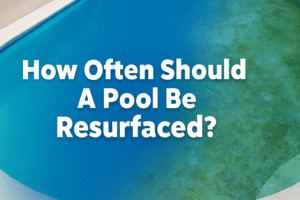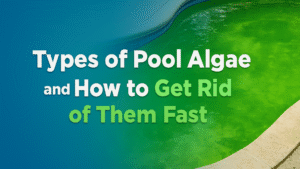Cloudy water, algae blooms, and unstable sanitizer levels signal it’s time for pool shock treatment—a powerful oxidation process that restores clarity and safety. You’ll learn exactly what pool shock treatment is, why it’s essential, how to shock your pool step by step, common mistakes to avoid, and best practices for post-shock maintenance. Whether you balance chemicals yourself or enlist professional support from South Florida pool service companies like Near Me Pools, this guide equips you with clear, actionable insights to keep your South Florida backyard oasis sparkling.
What Is Pool Shock Treatment and Why Is It Important?
Pool shock treatment is the process of adding a concentrated oxidizer—typically chlorine or a non-chlorine agent—to eliminate contaminants, organic debris, and algae spores in a single dose. By rapidly raising sanitizer levels, shock breaks down chloramines (combined chlorine compounds that cause odors) and destroys microscopic pathogens. For example, treating a cloudy summer pool after heavy use can slash bacteria counts and prevent green water outbreaks, setting the stage for reliable routine maintenance. Understanding these fundamentals leads naturally into how shock chemicals achieve such rapid sanitation.
How Does Pool Shock Work to Clean Your Pool?
Pool shock works by introducing strong oxidizing molecules—such as sodium dichlor or calcium hypochlorite—that react with organic matter and bacteria. When these oxidizers dissolve, they release active chlorine radicals that attack cell walls and break molecular bonds in contaminants. This mechanism ensures thorough sanitation, restoring water clarity and odor-free swimming conditions.
Key Oxidation Mechanisms
- Chloramine Breakdown completes in minutes, banishing eye irritation and chlorine smells.
- Algae Control kills spores before they spread, preventing green or yellow water.
- Organic Debris Oxidation converts leaves, sweat, and oils into harmless byproducts quickly.
These actions work together to create a sanitized baseline, preparing your pool for ongoing chemical balance.
When Should You Shock Your Pool?
Pool shock is most effective when used at these critical intervals:
| Scenario | Recommended Frequency |
|---|---|
| After heavy rain | Immediately |
| After a pool party | Within 24 hours |
| Algae or cloudiness appears | Once weekly |
| Weekly routine maintenance | Every 1–2 weeks |
Shock timing depends on usage, weather, and water tests. Addressing each situation promptly ensures persistent sanitation and crystal clarity.
What Are the Benefits of Regular Pool Shocking?
Regular pool shocking delivers three primary advantages:
- Enhanced Water Clarity by eliminating tiny particles that filter systems miss.
- Algae Prevention through proactive destruction of spores before they take hold.
- Bacteria Elimination by rapidly increasing free chlorine to safe, effective levels.
Keeping these benefits in focus streamlines routine care and reduces costly interventions later.
How Do You Properly Shock a Pool?
Proper shock application combines accurate measurement, even distribution, and safety measures. Following these steps ensures optimal results without damaging surfaces or equipment:
- Test and record current chlorine, pH, and alkalinity levels.
- Calculate required shock dosage based on pool volume and condition.
- Dissolve granular shock in a bucket of water if needed for non-chlorine products.
- Distribute shock around the pool perimeter with the pump running.
- Run filtration continuously for at least 8 hours after treatment.
Completing each step carefully prevents uneven dosing and maximizes sanitization before returning to routine balancing. For professional upkeep, consider our Pool Maintenance and Cleaning Services to handle these steps efficiently.
What Types of Pool Shock Chemicals Are Available?
Pool shock chemicals vary by composition and application. The following table compares common options:
| Shock Type | Active Ingredient | Primary Benefit |
|---|---|---|
| Calcium Hypochlorite | Calcium hypochlorite | High available chlorine |
| Sodium Dichlor | Dichlorinated isocyanurates | Fast dissolving, stable |
| Non-Chlorine Shock | Potassium monopersulfate | Chlorine-free oxidation |
Choosing the right shock hinges on pool finish, stabilizer levels, and desired turnaround time.
How Much Shock Treatment Should You Use?
Dosage depends on pool size and severity of contamination. Use this guideline:
| Pool Volume (gallons) | Shock Amount (oz) |
|---|---|
| Up to 10,000 | 4 |
| 10,000–20,000 | 8 |
| 20,000–30,000 | 12 |
Accurate measurement ensures safety and prevents over-chlorination. Proper dosing also supports faster recovery of ideal chlorine ranges.
Understanding Different Shocking Strategies: Regular vs. Aggressive Treatment
While routine shocking maintains water quality, some situations demand a more aggressive approach. When your pool is extremely dark, green, murky, or experiencing a severe algae bloom, a single dose of shock may not be enough to restore clarity. In these cases, pool owners often refer to “double” or “triple shocking” the pool.
- Regular Shocking (Maintenance): This involves adding the standard recommended dose of shock (as per the table above) to oxidize minor contaminants, break down chloramines, and prevent issues. It’s part of routine upkeep to keep water clear and sanitized.
- Aggressive Shocking (Algae/Severe Contamination): This strategy involves applying two to three times the standard shock dose. The goal is to rapidly elevate chlorine levels to a super-chlorination point that can effectively kill massive algae infestations and break down heavy organic loads that have turned the water opaque. This is typically done when the pool is visibly green, black, or so cloudy you cannot see the bottom.
When performing an aggressive shock, it’s crucial to retest water parameters frequently and ensure proper circulation to distribute the higher concentration of chemicals. This intensive treatment is aimed at quickly bringing the pool back to a swimmable, crystal-clear state, after which regular maintenance shocking can resume.
Disclosure: It is highly recommended you consult with a professional pool service such as Near Me Pools for any issues like pool algae that arise
Shocking Saltwater Pools: Special Considerations
Even though saltwater pools generate their own chlorine, they still require occasional shocking. The salt cell produces chlorine continuously, but it can struggle to keep up with heavy bather loads, extreme weather, or significant organic contamination. When free chlorine levels drop, or you notice cloudy water or algae, shocking becomes necessary.
Why Shock a Saltwater Pool?
- Break Down Chloramines: Just like traditional pools, saltwater pools can develop chloramines, leading to odors and eye irritation. Shocking oxidizes these compounds.
- Combat Algae: If algae starts to bloom, the chlorine generated by the salt cell might not be enough to eradicate it quickly. A shock treatment provides a rapid boost.
- Overcome Heavy Use: After a large pool party or prolonged hot weather, the chlorine demand can exceed the salt cell’s production capacity.
What Type of Shock to Use? For saltwater pools, it’s generally best to use non-stabilized chlorine shock, such as liquid chlorine (sodium hypochlorite) or calcium hypochlorite. Avoid using dichlor or trichlor shocks, as these contain cyanuric acid (CYA). Saltwater pools often accumulate CYA over time, and adding more can lead to over-stabilization, which reduces chlorine effectiveness.
How to Shock: The process is similar to traditional pools: test water, calculate dosage, dissolve granular shock if applicable, and distribute around the perimeter with the pump running. Ensure your salt cell is turned off during and immediately after shocking to prevent damage from the high chlorine concentration.
By understanding these nuances, saltwater pool owners can effectively maintain water quality and ensure their chlorine generator operates efficiently.
What Safety Precautions Should You Take When Shocking a Pool?
Handling concentrated oxidizers demands protective measures. Always:
- Wear chemical-resistant gloves and eye protection.
- Add shock to water—never pour pool water into the shock container.
- Keep children and pets away until sanitizer levels drop.
Maintaining these precautions ensures safe application and preserves pool finishes. If equipment needs inspection or repair before shocking, our Pool and Equipment Repairs team can help verify pump and filter readiness.
What Are Common Pool Shock Treatment Mistakes to Avoid?
Mistakes in pool shocking can waste chemicals and damage your pool. For reliable results, trust the expertise of About The Near Me Pool Company to guide best practices.
Can You Shock a Pool Too Often?
Yes, shocking too often can lead to scale buildup, faded plaster, or corroded liners. Overuse also drives chlorine demand higher, making balance more difficult.
What Happens If You Don’t Shock Your Pool Correctly?
Failing to shock properly allows chloramines and algae to persist, resulting in cloudy water, strong odors, and potential health risks from bacteria.
How Long Does It Take for Pool Shock to Work?
Pool shock typically oxidizes contaminants within 6–8 hours, depending on water temperature and circulation. This rapid action restores sanitizer efficacy and clears particles.
When Is It Safe to Swim After Shocking a Pool?
Wait until free chlorine levels drop below 5 ppm—usually 8–12 hours after shocking. Testing before entry ensures swimmer safety and comfort.
How Can You Test Pool Water After Shock Treatment?
After the wait period, verify:
- Free Chlorine remains between 1–3 ppm.
- pH Level sits in the 7.4–7.6 range.
- Cyanuric Acid (Stabilizer) matches recommended 30–50 ppm.
Accurate testing confirms a balanced pool ready for swimming.
How Can You Maintain Your Pool After Shock Treatment?
Ongoing maintenance preserves post-shock clarity and prevents future issues. For comprehensive chemical balancing, explore our Pool Services offerings.
What Are the Best Practices for Pool Water Balance?
Maintain balanced water by:
- Testing pH, alkalinity, and chlorine at least weekly.
- Adjusting alkalinity to 80–120 ppm before pH tweaks.
- Adding stabilizer for pools (like cyanuric acid) for consistent chlorine protection.
Consistent checks keep your pool in top swimming condition.
How Do You Prevent Future Pool Contamination?
Adopt routine strategies such as:
- Running filtration 8–12 hours daily during swim season.
- Brushing walls and vacuuming weekly to remove biofilm.
- Skimming debris after storms or heavy use.
For personalized guidance or to schedule a service visit, Contact Us and keep your pool pristine all year long.
Restoring your pool’s sparkle with the right shock strategy protects both water quality and equipment longevity. By following precise dosage, safety guidelines, and maintenance routines, you’ll enjoy lasting clarity, healthy water, and worry-free swims in South Florida’s sunshine. For professional support or routine cleaning, Near Me Pools is ready to help with tailored solutions and expert care.








